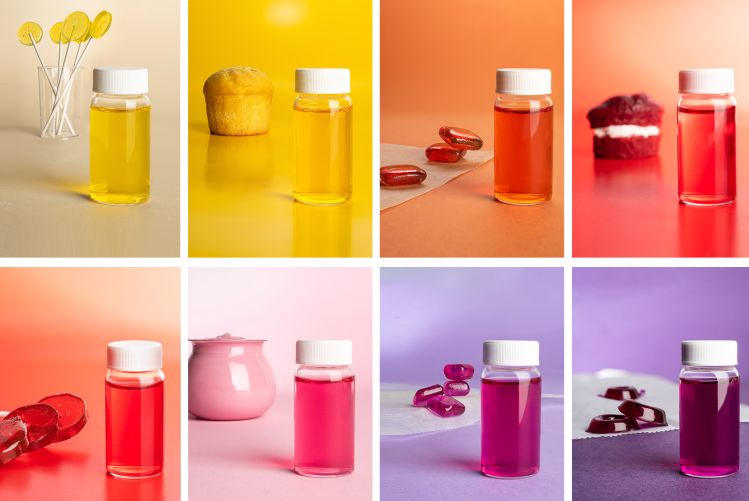Phytolon raises $14.5m to expand fermentation-based food color platform: 'We don't want agricultural land to be exploited for production of colors'

Phytolon’s platform, based on licensed technology from the Weizmann Institute of Science, can produce a wide range of natural colors from yellow to purple, and is currently at “semi-industrial” production scale, said co-founder and CEO Dr. Halim Jubran, who is also collaborating with synthetic biology specialist Ginkgo Bioworks.
“With Ginkgo, we are developing the next generation of strains that will produce the next generation of the colors.”
‘We are expecting to be in market in 2023’
The latest funding round “will enable us to get to the market” said Jubran, who noted that Phytolon has “already established partnerships with contract manufacturers to manufacture the colors,” and plans to work both with ingredient companies and establish direct relationships with CPG companies when it comes to sales.
“This round will enable us to expand our capabilities in terms of approaching the market and working with both types of companies,” added Jubran, who said the firm would be submitting a color additive petition to US regulators.
“We are expecting to be in market in 2023 [pending regulatory approval]. We have collected all of the data and together with our consultants, we are in communication with the FDA, which has already approved other fermentation based ingredients using baker’s yeast,” he told FoodNavigator-USA.
Asked about labeling in the US market, this is still to be determined, he said, “it may be something like ‘fermented beet colors’,” but as the colors themselves are not GMOs (rather they are produced by GM baker’s yeast, which is filtered out of the final product) they will not be subject to bioengineered food labeling laws, he said noting that several firms now use genetically modified microbes to produce colors, sweeteners, texturants such as xanthan gum, vitamins (B2, B12, ascorbic acid etc.), and enzymes.
‘You can almost produce anything in any microbe, but the question is, is it efficient and scalable?’
Phytolon is one of several firms using microbes to produce food colors, including Impossible Foods and Motif FoodWorks, which make soy leghemoglobin and myoglobin respectively (imparting a red color and a ‘meaty’ flavor) from engineered yeast; Lycored and others using Blakeslea trispora to make beta-carotene; Michroma (using CRISPR to optimize filamentous fungi strains that produce stable red colors); Spira (using CRISPR to optimize the cyanobacteria spirulina to produce more stable blue colors); and DDW (using the microalgae Galdieria sulphuraria to produce blue colors).
“Moving from traditional agriculture to microorganisms, this is the current revolution that is happening,” claimed Jubran.
“But cell-free systems also need to be explored [eg. Debut Biotech is working with DIC to develop color ingredients via a novel ‘cell-free’ biomanufacturing platform, which it claims could enable the biosynthesis of colors that are “hard to find or even inaccessible in nature"."
So where does Phytolon fit into this landscape, how efficient is yeast at producing food colors, and are Phytolon’s colors designed to replace synthetic dyes, or potentially compete with some colors extracted from plants?
According to Jubran: “Basically, today you can almost produce anything in any microbe, but the question is, is it efficient and scalable? When you try and produce betalains in yeast, we discovered that the yeast cells spontaneously release colors out of the cells, which provides a great advantage as a system because once colors are released, the cells can produce more and more color.
“But also you do not need to explode the cells to get the color out [which means less expensive downstream processing] so you get a pure color without any impurities from the yeast, which puts us in a good position in terms of competition with plant extracts and other fermented based colors.”

Red velvet cake
But what about the colors themselves? Are they able to match the stability and vibrancy of synthetic dyes, and how do they compare to colors extracted from fruits and vegetables?
“In bakery applications,” he claimed, Phytolon’s betalain pigments “are more heat stable than natural colors from plant extracts, so applications such as red velvet cake, some potential clients are very interested in.”
He noted that betalain pigments – whether from fermentation or plants - are stable in a wide range of pH conditions, “especially in acidic pH, where a lot of natural colors fade.”
‘We have two production strains, one for purple and one for yellow. By mixing the colors, you can obtain pinks, reds, oranges, as well’
So what colors can Phytolon make, and which ones are the food industry most interested in?
“The red and the purple colors are really desired," said Jubran. "We have two production strains, one for purple and one for yellow. By mixing the colors, you can obtain pinks, reds, oranges, as well, so a full color palette. But the major interest is in the reds and the purples.”
He added: “The two production strains are pretty similar, it’s basically the same metabolic pathways to make the colors that you can find in beets or cactus fruits.”

‘We are not yet as cheap as synthetic colors’
As for price, he said, “We already see that in most of applications with most of the colors we have an economical advantage over the competition [in natural colors] but we are not yet as cheap as the synthetic colors.”
‘They don't want agricultural land to be exploited for production of colors’
Asked whether there is any hesitation on the part of food companies to use natural colors produced via fermentation as opposed to extracted from plants, he said: “They don't want agricultural land to be exploited for production of colors, but for food production, or not exploited at all. So, this is not only about economics but sustainability, not only for food colors, but for all kinds of food ingredients.”
*The series A round was led by DSM Venturing, the corporate venture arm of Royal DSM, with participation from Cibus Fund, Ginkgo Bioworks (in-kind investment in the form of Foundry services) and The Trendlines Agrifood Fund. Some of Phytolon’s current shareholders also participated in the round, including The Trendlines Group (the largest shareholder in the company), Arkin Holdings, Millennium Foodtech, Agriline (administered by Consensus Business Group), Stern Tech, and OpenValley/Yossi Ackerman.
























